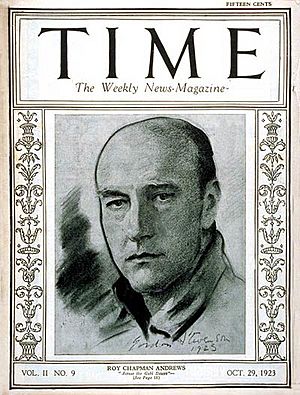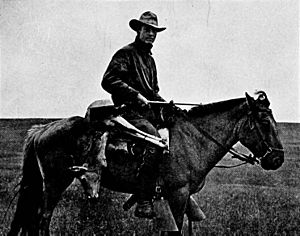Roy Chapman Andrews facts for kids
Quick facts for kids
Roy Chapman Andrews
|
|
|---|---|
 |
|
| Born | January 26, 1884 Beloit, Wisconsin, U.S.
|
| Died | March 11, 1960 (aged 76) |
| Resting place | Oakwood Cemetery, Beloit, Wisconsin, U.S. |
| Nationality | American |
| Occupation | Explorer, adventurer, naturalist |
| Years active | 1909–1961 |
| Employer | American Museum of Natural History |
| Known for | Paleontological field work |
| Spouse(s) | Yvette Borup, Wilhelmina Christmas |
| Awards | Hubbard Medal (1931) Charles P. Daly Medal (1935) Vega Medal (1937) Cover of Time Magazine, October 29, 1923 |
- For the former professional American football coach see LeRoy Andrews
Roy Chapman Andrews (January 26, 1884 – March 11, 1960) was an American explorer, adventurer, and naturalist. He later became the director of the American Museum of Natural History. He is best known for leading many trips into the Gobi Desert and Mongolia. These expeditions made important discoveries, like the first known fossil dinosaur eggs. His exciting books about his adventures made him very famous.
Contents
Biography
Early life and education
Roy Chapman Andrews was born in Beloit, Wisconsin, on January 26, 1884. As a child, he loved exploring the forests, fields, and rivers near his home. He became very good at shooting.
He taught himself how to prepare animal specimens (called taxidermy). He used the money he earned from this hobby to pay for his studies at Beloit College. After college, Andrews wanted to work at the American Museum of Natural History in New York City.
Even though there were no jobs at his level, he took a job as a janitor in the taxidermy department. He also started collecting animal specimens for the museum. Over the next few years, he worked and studied at the same time. He earned a master's degree in studying mammals from Columbia University. In 1908, he joined The Explorers Club in New York.
Career as an explorer
From 1909 to 1910, Andrews sailed on the USS Albatross to the East Indies. On this trip, he collected snakes and lizards. He also observed marine mammals like whales and dolphins.
In 1913, he sailed to the Arctic on a ship called the Adventuress. He hoped to find a bowhead whale for the museum. He filmed some amazing footage of seals during this trip.
He married Yvette Borup in 1914. From 1916 to 1917, Andrews and his wife led an expedition through parts of Yunnan and other areas of China. Their adventures are written about in the book Camps and Trails in China.
Discoveries in Mongolia
In 1920, Andrews started planning big expeditions to Mongolia. He drove a group of Dodge cars westward from Beijing. In 1922, his team found a fossil of a gigantic hornless rhinoceros. This huge fossil was sent back to the museum. A fossil species called Andrewsarchus was later named after him.
Andrews believed that humans might have first appeared in Asia. He led several trips to Asia from 1922 to 1928, called the "Central Asiatic Expeditions." He was looking for the earliest human remains.

Even though they didn't find human remains, Andrews and his team made many other important discoveries. They found many dinosaur bones and fossil mammals. Most famously, they found the first nests full of dinosaur eggs ever discovered. Andrews wrote about these trips in his book The New Conquest of Central Asia.
On July 13, 1923, his team made history by finding the first dinosaur eggs. At first, they thought the eggs belonged to a dinosaur called Protoceratops. But in 1995, scientists found out they actually belonged to a dinosaur called Oviraptor.
During the same expedition, Walter W. Granger found a skull from the Cretaceous period. In 1925, the museum told them the skull was from a mammal, which made it even more special. More mammal fossils were found later.
Expeditions in the area stopped in 1926 and 1927. In 1928, Chinese officials took the expedition's finds, but they were eventually returned. The 1929 trip was canceled. In 1930, Andrews made one last trip and found some mastodon fossils. A filmmaker, James B. Shackelford, recorded many of Andrews' expeditions.
Later that year, Andrews returned to the United States. He divorced his first wife, with whom he had two sons. He married his second wife, Wilhelmina Christmas, in 1935.
Later life

In 1927, the Boy Scouts of America made Andrews an Honorary Scout. This honor was given to Americans whose outdoor adventures were so amazing they inspired boys.
Andrews was the President of The Explorers Club from 1931 to 1934. In 1934, he became the director of the Natural History museum. In his 1935 book The Business of Exploring, he wrote, "I was born to be an explorer...There was never any decision to make. I couldn't do anything else and be happy."
In 1942, Andrews retired to Connecticut. He wrote most of his books about his life and adventures there. In the late 1950s, he moved to Carmel Valley, California.
He died on March 11, 1960, in Carmel-by-the-Sea, California. He is buried in Oakwood Cemetery in his hometown of Beloit.
Association with character "Indiana Jones"
Many people believe that the movie character Indiana Jones was based on Roy Chapman Andrews. However, neither George Lucas nor the other creators of the films have confirmed this. Other explorers, like Percy Fawcett, have also been suggested as inspirations.
An analysis by the Smithsonian Channel suggests that the connection was indirect. Andrews and other explorers inspired adventure film heroes from the 1940s and 1950s. These older movie heroes then inspired Lucas and his writers.
|
See also
 In Spanish: Roy Chapman Andrews para niños
In Spanish: Roy Chapman Andrews para niños



